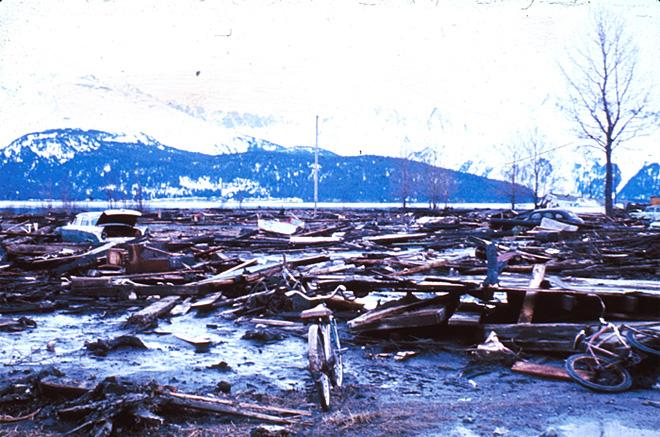

Now, a full half-century after Alaska’s gigantic quake, geologists are still feeling its effects.

The only stronger trembling ever recorded was a magnitude-9.5 monster that shook Chile in May 1960. The Great Alaskan Earthquake was a magnitude-9.2 event. Similar sloshing swamped fishing boats in Louisiana. Quake effects were felt in nearly every state.In Washington, Seattle’s Space Needle swayed like a tree in the wind. Underwater landslides along the Seward, Alaska, waterfront triggered the strong waves which hit here, 2 miles (3.2 kilometers) from Seward. The yellow cab of the truck wrapped around the right side of a tree its wheels around the left side. This vehicle illustrates the force of the tsunami waves that had struck this truck, which had been 32 feet (9.8 meters) above sea level at the time of the quake. Indeed, like ripples in a pond, a tsunami travels outward in all directions. Most had been killed by the tsunami waves that raked not just the coast of Alaska, but Oregon and California too. No Alaskan who survived would ever forget this day. They washed away everything in their immediate path - buildings, docks and people. In places, the waves towered as high as a 20-story building. Together, these destructive waves swept Alaska’s coastline with devastating speed and power. These unleashed more tsunamis.Įxplainer: Telling a tsunami from a seiche In bays and inlets, the quake also triggered underwater landslides. That movement generated huge and fast-moving waves in the open ocean, called tsunamis. The earthquake had uplifted large sections of seafloor. Then, as Alaska’s shaking ceased, things got worse - much worse. Geological Survey (USGS) in a recent publication. “It was so large that it caused the entire Earth to ring like a bell,” observes seismologist Tom Brocher and his colleagues from the U.S. But 50 years ago, that now infamous Alaska quake shook steadily and terrifyingly for almost five solid minutes. Most earthquakes rattle the ground for just seconds. In Valdez, the ground beneath the harbor slumped - and nearly swallowed a ship docked there. Indeed, the state averages some 60 each day - about 22,000 a year. At 5:36 p.m., the ground began shaking violently. Yet as dusk approached on this Good Friday, just two days before Easter, a major upheaval was in store. This fact sheet commemorates Great Alaska Earthquake and examines the advances in knowledge and technology that have helped to improve earthquake preparation and response both in Alaska and around the world.March 27, 1964, was a quiet day in Alaska. The leap in scientific understanding that followed the 1964 earthquake has led to major breakthroughs in earth science research worldwide over the past half century.

Although the Great Alaska Earthquake was tragic because of the loss of life and property, it provided a wealth of data about subductionzone earthquakes and the hazards they pose. Most of the population of Alaska and its major transportation routes, ports, and infrastructure lie near the eastern segment of the Aleutian Trench that ruptured in the 1964 earthquake.

Altogether the earthquake and subsequent tsunamis caused 129 fatalities and an estimated $2.3 billion in property losses (in 2013 dollars). Tsunamis produced by the earthquake resulted in deaths and damage as far away as Oregon and California. Alaska’s largest city, Anchorage, located west of the fault rupture, sustained heavy property damage. The Great Alaska Earthquake spawned thousands of lesser aftershocks and hundreds of damaging landslides, submarine slumps, and other ground failures. It was so large that it caused the entire Earth to ring like a bell: vibrations that were among the first of their kind ever recorded by modern instruments. Water-level recorders in 47 states-the entire Nation except for Connecticut, Delaware, and Rhode Island- registered the earthquake. The earthquake caused rivers, lakes, and other waterways to slosh as far away as the coasts of Texas and Louisiana. The earthquake was felt throughout most of mainland Alaska, as far west as Dutch Harbor in the Aleutian Islands some 480 miles away, and at Seattle, Washington, more than 1,200 miles to the southeast of the fault rupture, where the Space Needle swayed perceptibly. history and the second-largest earthquake recorded with modern instruments. on Friday, March 27, 1964, is the largest recorded earthquake in U.S. The magnitude 9.2 Great Alaska Earthquake that struck south-central Alaska at 5:36 p.m.


 0 kommentar(er)
0 kommentar(er)
